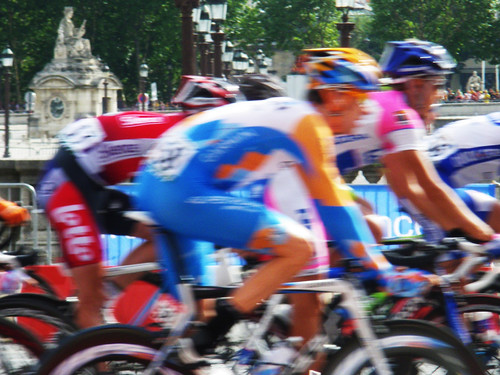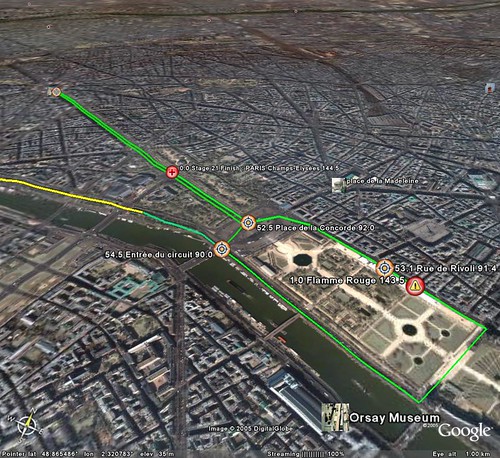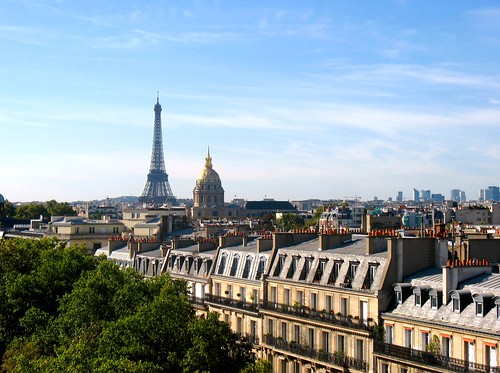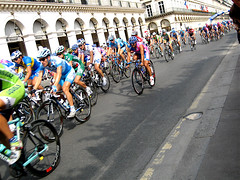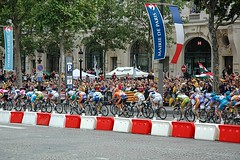Le Tour reminds us why we love Paris

Posted July 26, 2010 at 2:53PM
Surely the most majestic sight in all of sport that involves actual competition,* yesterday the peloton of Le Tour de France entered Paris en masse, led by the Astana team of deserving race winner Alberto Contador. By tradition, the riders don’t attack each other on the final day until after they have ridden along the Seine, the Eiffel Tower in view, turned up to La Place de la Concorde and onto the Champs-Elysées toward the Arc de Triomphe, and completed at least one of their eight laps up and down the Avenue before the final sprint. In years when the race approaches from the east, they ride along the Seine past the magnificent cathedral Notre Dame, but this year they entered from the west (see route below; the Tour goes around France clockwise and counter-clockwise in alternating years). I saw the race finish in Paris in person once, but this year I settled for TV.
Paris has to be on the short list of the world’s most loved cities, probably at the top for many of us, and not without reason. The cafés, the art, the monuments, the beautiful architecture, the graceful elegance of the residents, and of course the light. Cities can’t take light for granted, one reason I defend Washington’s building height limit. Paris, although the densest of the western capitals by most measures, is a city not of skyscrapers but rather mostly of five- to eight-story buildings in the core. It makes a difference. The liveliness and walkability that the city’s density fosters is spectacular, but it seldom feels overwhelming, the scale still within reason for human beings.
While Paris doesn’t have the everyday bicycling culture of, say, Copenhagen, Amsterdam or some Asian cities, it did pioneer its wildly popular Velib’ bike-sharing program. When I was there last fall, I was astounded by how many people were riding the Velib’ bikes on virtually every block, picking them up at one station and dropping them off at another, if that was more convenient than returning. Shortly after coming back home I read a story in the New York Times about how many of the bikes had been vandalized or stolen, but I saw no evidence of that. I saw a really popular program in full use.
At the other end of the transportation spectrum, Paris is the hub for France’s wonderful high-speed rail network, and le TGV 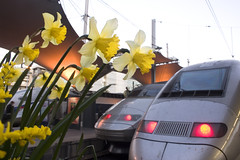 (Train a Grand Vitesse) was not only the first but remains the fastest service in Europe. (A test TGV train also lodged the world’s fastest time for a wheeled vehicle in 2007.) In the US, we’re still floundering with whether, when or where we might have high-speed rail service someday, but the TGV was launched in 1981, nearly 30 years ago. Last year even the Tour riders took the service from Avignon to Paris, having completed their stage up Mont Ventoux near Avignon shortly before their final time trial and finishing stage into Paris.
(Train a Grand Vitesse) was not only the first but remains the fastest service in Europe. (A test TGV train also lodged the world’s fastest time for a wheeled vehicle in 2007.) In the US, we’re still floundering with whether, when or where we might have high-speed rail service someday, but the TGV was launched in 1981, nearly 30 years ago. Last year even the Tour riders took the service from Avignon to Paris, having completed their stage up Mont Ventoux near Avignon shortly before their final time trial and finishing stage into Paris.
One could write books about the many things that make Paris special, and quite a few have; likewise with the Tour. I don’t think I can quite convince NRDC to pay me to do that, and needn’t write much more anyway, since the photos do a very evocative job of it on their own. But I do want to mention one more thing – the Paris-Plages, where for a month in the summer the city has begun closing roads by the Seine and setting up urban beaches for the Parisians and visitors simply to enjoy.  Here’s the Project for Public Spaces on les Plages:
Here’s the Project for Public Spaces on les Plages:
“For one month every summer, the Georges Pompidou Expressway along Paris’s Right Bank [note: and now also a stretch of roadway along the Rive Gauche] transforms into a pedestrian refuge replete with a sandy beach. A dazzling array of attractions vie for your attention, from activities like dance lessons, climbing walls, games, and swimming (in floating pools, not the Seine, thankfully), to amenities like beach chairs, cafes, misting fountains, and shady palm trees. Its enormous popularity can be traced to strong management and innovative programming, which keep the place humming well into the night with shows and performances. Though financed in part by corporate sponsors, the acknowledgements are appropriately modest. There are no outrageous logos on display, and the experience never feels overwhelmed by commercialism. Paris Plage is a truly public space of tremendous benefit to everyone.”
Not too shabby. I wonder if they are serving mojitos and margaritas, too? Not very French but, hey, it’s a beach.
Back to the race, I was rooting for Alberto all along this year, but he had a far worthier challenger this time than in his four other major tour victories (two previous Tours de France, plus a Giro d’Itlalia and a Vuelta a Espana) in the very likeable Andy Schleck from Luxembourg. Andy matched Alberto in the mountains but not (quite) in the time trials. Andy’s fans can parse his misfortune on stage 15 and Alberto’s fans can do the same about stages 2 and 3, but the truth is that they were very evenly matched, with Alberto slightly better this year. I love it that the two are friends off the bike and had some great moments of sportsmanship. Less well-known riders also had terrific races in their own ways, from the ridiculously strong Fabian Cancellara of Switzerland to the brilliant sprinter Mark Cavendish of the UK to French stage heroes Thomas Voeckler and Sylvain Chavenel. It was a great race, and what better way for the riders to finish it off than a spin around the City of Light?
Here’s a 3-minute video of highlights from this year’s Tour:
Speaking of races, congratulations to my friend (and friend to some of my readers, too) Victor Dover on completing yesterday’s Ironman Lake Placid, a grueling 2.4-mile swim, 112-mile bike race, and 26.2-mile runners’ marathon, in succession!
______________
*One can make a strong case for the entrance of the athletes into the stadium in the opening ceremony of the Olympic Games, but they aren’t competing at the time.
Move your cursor over the images for credit information.

